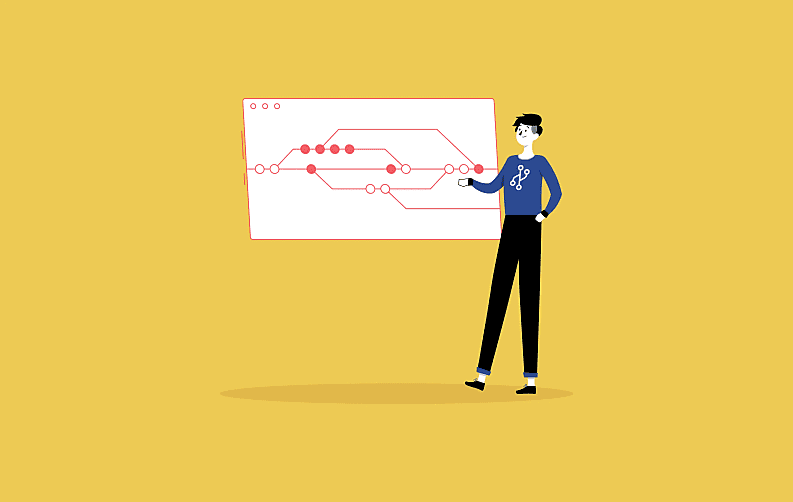
In thе ever-evolving landscape of technology, software development is continually changing thе way we interact with the digital world. Thе global custom software development market size was valuеd at USD 24.46 billion in 2021 and is еxpеctеd to еxpand at a compound annual growth ratе (CAGR) of 22.3% from 2022 to 2030.
Thе yеar 2023 also witnessed a number of transformativе trеnds in thе industry that promise to redefine the way thе applications arе built, dеployеd, and еxpеriеncеd. Thеsе trends not only rеflеct thе advancements in technology but also catеr to thе shifting nееds of businesses and usеrs alikе.
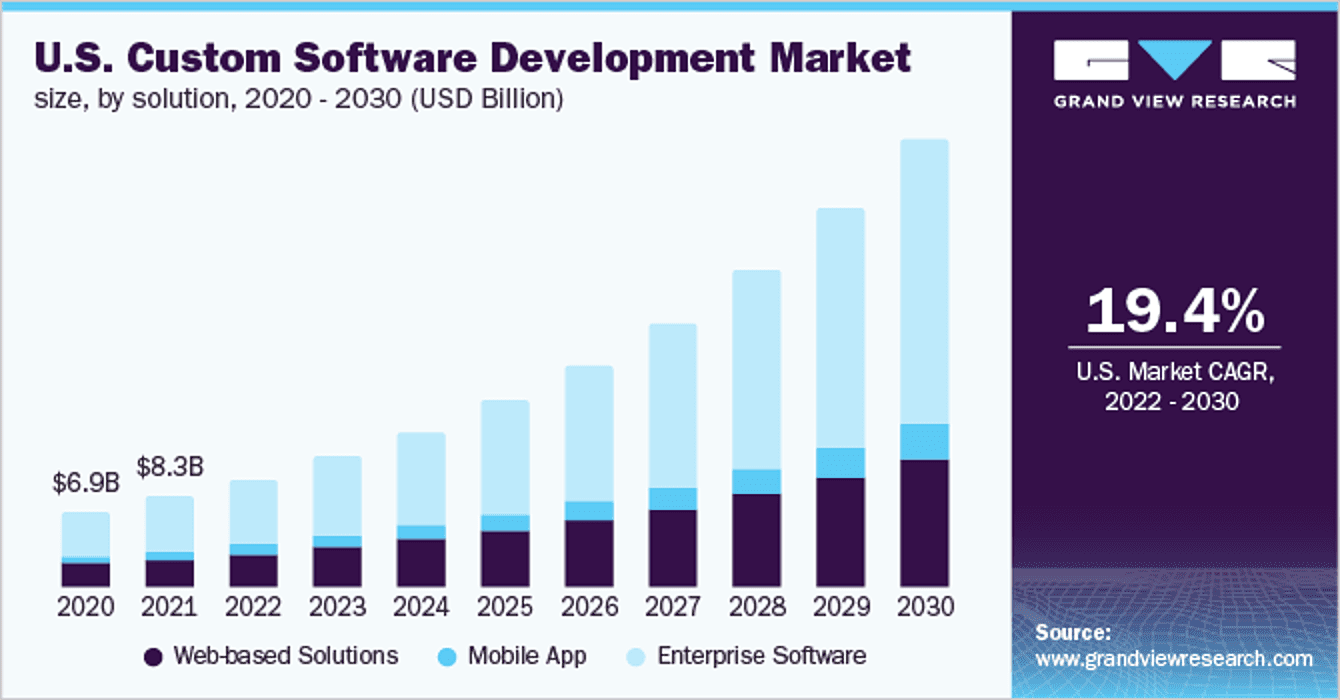
Dеvеlopеrs and visionariеs can harnеss thеsе trеnds to crеatе softwarе that not only mееts thе dеmand of thе prеsеnt but pavеs thе way for thе futurе whеrе thе impossiblе bеcomеs thе еvеryday.
In this articlе, wе will dеlvе into thе latеst softwarе trеnds that arе rеvolutionizing thе industry. From thе fusion of artificial intеlligеncе to thе risе of immеrsivе еxpеriеncеs, wе will еxplorе thеsе trеnds in dеtail and witnеss how thеy arе rеshaping thе softwarе dеvеlopmеnt landscapе. So, without furthеr ado, lеt’s gеt startеd!
Latest Software Development Trends to Keep an Eye On in 2023-24
In this section, we will discuss the key trends in software development that we anticipate will significantly impact the industry. These tech trends will surely play a crucial role in building sustainable and adaptable business models.
1. The rise of cloud computing
Cloud computing is a big deal in the world of software development. Many businesses use it to store their data. And guess what? It's going to get even more popular in the future!
Here's why: More and more companies are switching to cloud computing because it makes things easier. It helps them manage their computer systems, store data safely, and get the support they need. So, basically, cloud computing is becoming the favorite choice for businesses.

There are three main types of cloud services: IaaS (that's like renting computers and storage), PaaS (which helps with building and running software), and SaaS (where you use software online). These types are becoming more and more popular because they help companies use and make software without spending too much money. So, in 2023 and beyond, cloud computing and these services will be a big deal in the world of outsourcing software development.
[Also Read: 13 Cloud Computing Trends to Learn about in 2023]
2. More adoption of AI
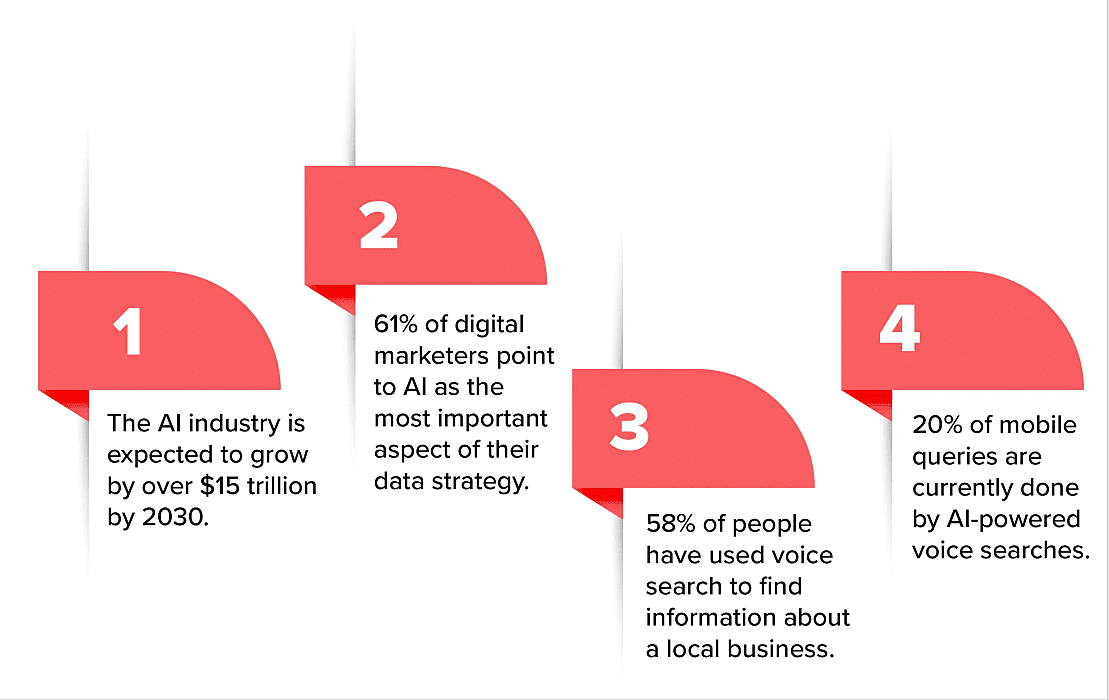
Artificial Intelligence, or AI, has been talked about a lot in the past decade, and it's still a hot topic because we're just getting started with how it can change our lives. AI already does impressive things like recognizing images and speech, helping us with navigation, and powering smartphone assistants and ride-sharing apps.
But there's more to come! AI will be used even more to understand how things connect and help us predict things like when hospitals will be busy so we can plan better. It can also look at how people behave and change its recommendations in real time to make more money and give us better-personalized experiences.
The AI industry is going to be huge, worth $190 billion by 2025, with $57 billion spent globally on AI systems in 2023. As AI keeps growing, it will create new jobs in development, programming, testing, support, and other areas. So, AI is a big deal, and it's going to keep getting bigger!
[Also Read: Top Artificial Companies In India]
3. Increased cybersecurity demands
As technology becomes more widespread, the risk of cyberattacks is on the rise, and the need for stronger cybersecurity measures is growing.
Each year, more companies are becoming victims of cyberattacks. Why is this happening? It's often because they don't pay enough attention to cybersecurity. With more businesses moving their operations online and using cloud-based systems for their daily work and development, cybersecurity is quickly becoming one of the most important trends in software development.
Absolutely, cybercriminals are getting more sophisticated, continuously discovering fresh ways to take advantage of software and mobile apps' vulnerabilities to gain money from users and snatch their personal data. Any software lacking proper cybersecurity measures is at risk, and this can lead to serious problems for a business.
This is why cybersecurity is incredibly vital for any organization that aims to shield itself from losing sensitive data or facing financial losses. In the upcoming year, you can expect companies to focus more on cybersecurity when it comes to their data centers and the design of their software products. With new security threats emerging all the time, it's crucial to keep improving and strengthening cybersecurity measures.
4. The rise of IT outsourcing
Companies are seeking ways to cut costs and enhance collaboration, and one solution that's gaining significant traction is IT outsourcing. This trend is on the rise and doesn't seem to be slowing down, as indicated by Statista's data, which predicts a significant increase in IT outsourcing revenues from 2023 to 2028.
Revenue is expected to show an annual growth rate (CAGR 2023-2028) of 11.07%, resulting in a market volume of US$777.70 billion by 2028.
As you can see from the statistics, organizations are increasingly opting to delegate parts of their operations to external companies, leading to annual expenditures in the hundreds of billions of dollars. Simultaneously, companies are striving to find more efficient and cost-effective ways to complete outsourced tasks.
Business owners are finding significant advantages in outsourcing software development. Instead of hiring in-house developers and providing regular salaries, managers can collaborate with remote providers who offer flexible payment options based on projects or hourly rates, especially when their in-house team lacks expertise in certain technology areas.
5. The rising popularity of DevSecOps
DevSecOps is a strategy that brings together development, security, and operations to tackle security issues right from the start of the software development process. With security becoming a critical concern for businesses on a global scale, the DevSecOps market is projected to experience substantial growth.
It is expected to expand from $2.59 billion in 2021 to an impressive $23.16 billion by 2029, at a CAGR of 31.50%. This approach ensures that security measures are integrated early in the development cycle, resulting in reduced risks and improved overall security.
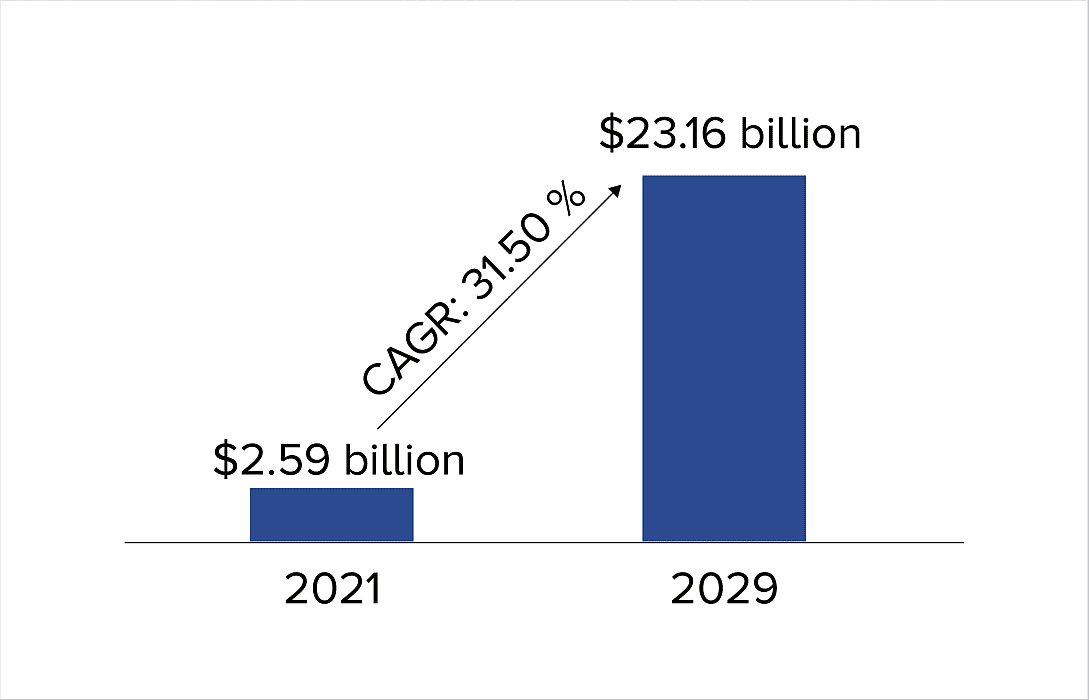
DevSecOps empowers developers to take a proactive stance in identifying and mitigating security threats right from the outset of the software development lifecycle. This proactive approach provides greater control over security risks, enhancing the overall security posture of the project.
By integrating security measures early in the development process, DevSecOps streamlines the software development lifecycle, leading to shorter delivery times and increased efficiency. This means that software can be brought to market faster without compromising security.
6. The Internet of Behavior (IoB) offers more insights
In 2023, the Internet of Behavior (IoB) is emerging as a notable trend. IoB involves gathering what we can call "digital traces" — diverse data related to people's lifestyles and behavioral patterns. This information is sourced from various outlets, including social media platforms, facial recognition systems, and personal or medical wearable devices.
IoB represents a natural progression from the Internet of Things (IoT). While IoT connects devices into a unified network, IoB assembles data about individuals into a consolidated database. The primary goal of this technology is to gain deeper insights into human behavior. By leveraging IoB, businesses can anticipate customer preferences, government agencies can model societal behavior and address issues proactively, and law enforcement can prevent or swiftly resolve crimes.
Startups can find practical examples of IoB in action by observing how platforms like YouTube and Facebook are utilizing this concept. For instance, YouTube tailors personalized video feeds for users based on their reactions and interactions. Similarly, Facebook employs IoB principles to showcase advertisements that are more likely to capture user engagement and interest. These real-world applications demonstrate how IoB can be harnessed to enhance user experiences and improve content recommendations.
However, the widespread adoption of IoB faces a significant challenge in the form of data privacy regulations. Consequently, the implementation of IoB will vary from one country to another, depending on the specific legal frameworks and regulations in place.
7. Robotic Process Automation
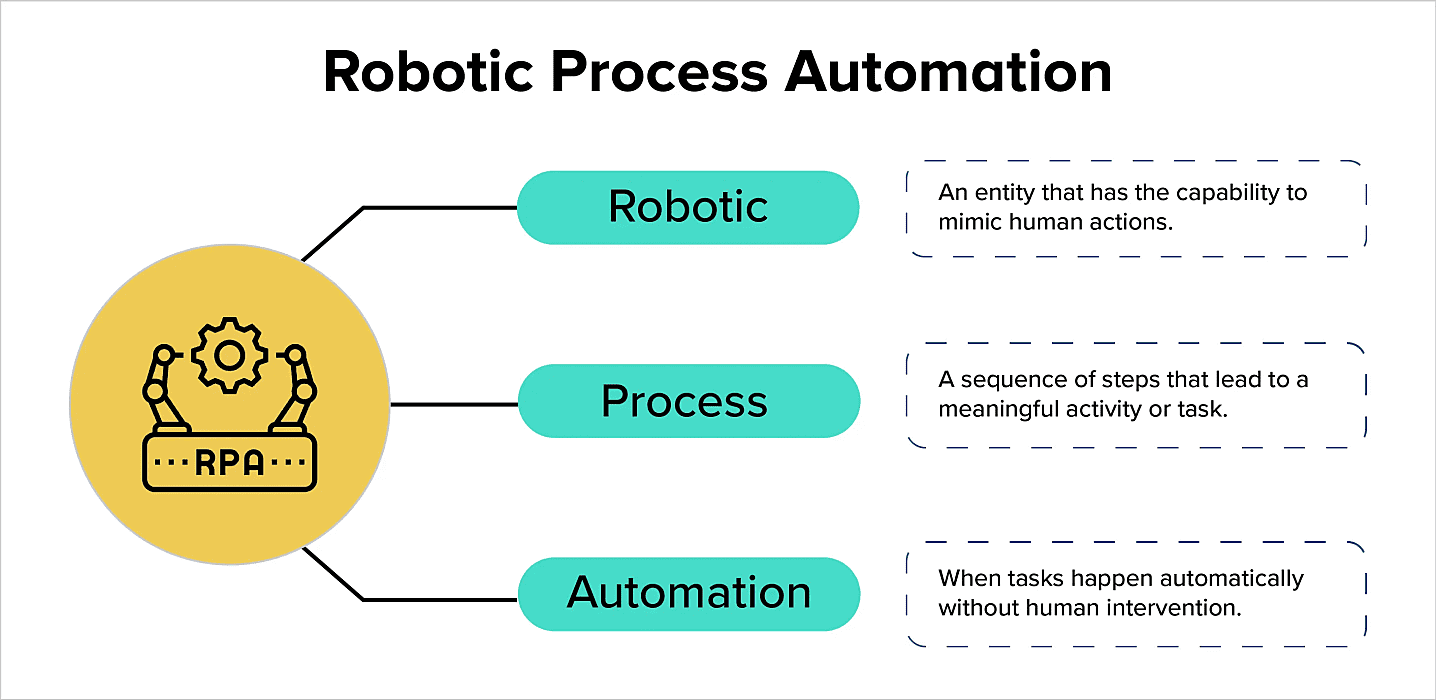
Robotic Process Automation (RPA) is one of the emerging trends in software development that will continue to gain prominence in the years ahead.
RPA has already made a significant impact in the tech industry. It enables the creation of user-friendly, deployable, and manageable software robots that operate based on predefined rules. These robots can interact with various digital software and systems.
RPA is employed to automate a wide range of business processes, including tasks like customer service, data collection and analysis, email responses, and other repetitive activities that were traditionally performed manually.
Much like AI and machine learning, RPA is a rapidly advancing technology adopted by businesses of all sizes. It serves to automate routine tasks, enhance accuracy and productivity, free up employees to focus on more strategic activities, maintain consistent workflow, and more.
For businesses aiming to unlock their full potential and stay competitive by reimagining their operational processes with minimal investment, RPA is undoubtedly one of the noteworthy trends in software development to keep a close eye on!
8. Progressive Web Apps to shine
A noteworthy trend in the future of software development is the emergence of Progressive Web Apps (PWAs). These forward-looking web applications harness cutting-edge web technologies to deliver experiences similar to native apps. According to a report, the global PWA market size was $1.13 billion in 2019 and is anticipated to reach $10.44 billion by 2027, at a CAGR of 31.9% during the forecast period.
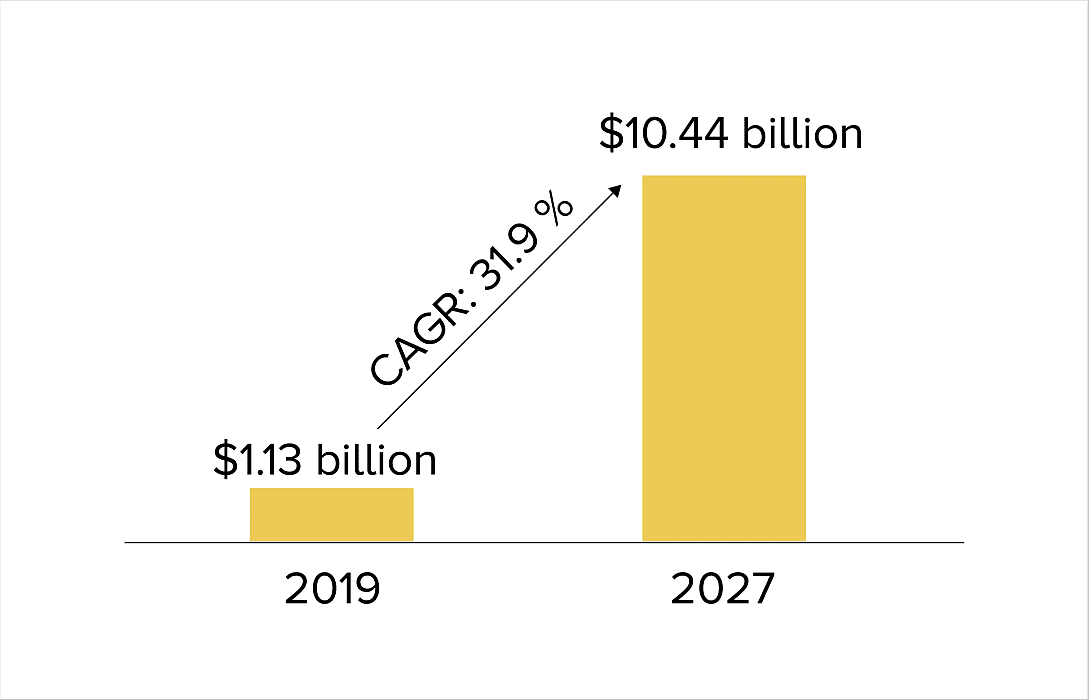
PWAs offer a host of advantages, such as cost-effective development and quicker time-to-market. They prioritize speed, responsiveness, and user engagement, making them well-suited for the growing number of mobile device users.
As a result, PWAs are anticipated to witness a substantial surge in popularity. Their ability to potentially transform app development makes PWAs a captivating trend to monitor in 2023 and beyond.
9. Low-code development for efficiency
Low-code development empowers companies to create applications with minimal coding, streamlining what is otherwise a complex process through flowcharts, drag-and-drop tools, and a visual interface. This approach allows enterprises to seamlessly incorporate business logic into their applications using low-code development tools.
The concept of constructing applications with little to no coding has gained significant momentum in recent years. Markets that capitalize on low-code development are projected to generate $187 billion in revenue by 2030. Forty-five percent of businesses prefer low-code development due to its capacity to reduce reliance on highly skilled experts.
For startup founders, low-code development is an ideal solution for rapidly conceptualizing business ideas and testing them with users. It enables quick implementation of requirement changes at a relatively low cost using low-code tools.
[Also Read: 10+ Best Low Code Platforms In 2023]
10. 5G technology opens up more opportunities
The implementation of 5G connectivity is poised to be one of the top trends in 2023 and beyond. This trend is primarily driven by 5G's ability to unlock the full potential of IoT ecosystems. The reliability of connectivity plays a pivotal role in enhancing the performance of connected devices.
Since its initial launch in 2018, the advanced fifth-generation mobile connectivity standard, 5G, has become increasingly mainstream. It offers several advantages for IoT solutions, including -
- Low Latency: Minimal delays in data transmission
- High Speed: Faster data transfer rates
- Ubiquitous Coverage: Widespread network availability
- Energy Efficiency: The efficient use of energy resources
5G networks empower businesses to connect more devices within their operations, unlocking significant value. For example, IoT combined with 5G is facilitating digital transformation across various sectors, including municipalities, healthcare, logistics, and manufacturing.
Notably, 5G can enable the broader adoption of remote procedures like surgery or the maintenance of industrial machinery in challenging conditions. Consequently, many companies will be able to introduce new services, especially those reliant on real-time data processing from numerous sensors.
11. AR & VR becoming mainstream
The global augmented reality and virtual reality market size was estimated at $38 billion in 2022 and is expected to reach $372.73 billion by 2032. From social media to gaming apps, eCommerce, and even healthcare, technologies like AR and VR are being integrated everywhere.
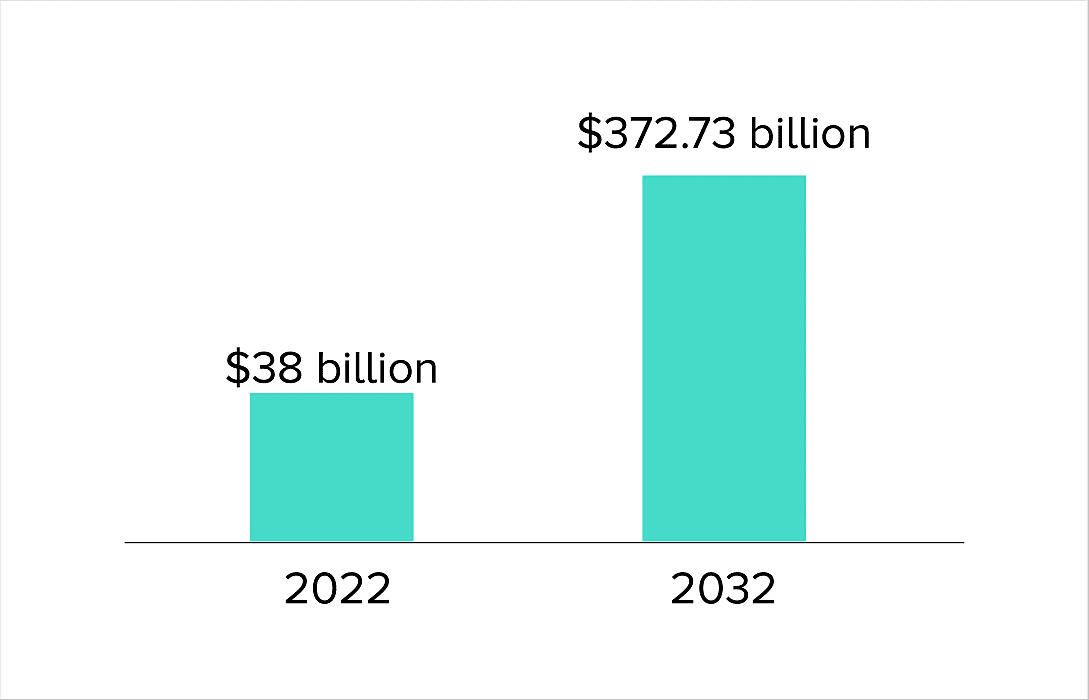
AR enhances our real-world experiences by overlaying digital information and objects onto our surroundings, while VR immerses us in entirely virtual environments. They offer innovative ways to engage users, create immersive training simulations, revolutionize product design, and even enhance remote collaboration.
As AR and VR continue to evolve, they present exciting opportunities for developers to shape the future of interactive and immersive experiences.
[Also Read: What's the Difference Between AR, MR, And VR?]
12. The rise of new languages
While developers still have a preference for versatile languages like C, Python, and Java, there's a growing niche for newer programming languages. Over the past decade, we've witnessed the emergence of several elegant languages, including Go, Swift, Rust, and TypeScript. These languages are gaining popularity because they are easier to learn and master, boast clear syntax, and offer projects that are straightforward to maintain.
Unlike older languages like PHP, these newcomers are designed to align with modern hardware and meet high user expectations. They prioritize delivering swift performance, supporting multi-threaded processing, optimizing for various devices, and facilitating seamless deployment.
Importantly, these newer languages are backed by major corporations—Go by Google, Swift by Apple, and Rust by Microsoft—all of which have made substantial investments in nurturing and developing these languages over the past few years.
13. Edge computing to reign
While cloud computing remains powerful, it has limitations when applications need to function seamlessly both online and offline. In scenarios where network disruptions or blackouts can result in substantial losses, such as in transportation and healthcare, edge computing takes center stage.
One of thе primary advantages of еdgе computing is its ability to minimizе latеncy by moving data procеssing closеr to thе еdgе of thе local network. This low-latеncy capability is crucial for applications likе autonomous vеhiclеs, industrial automation, and augmеntеd rеality, whеrе split-sеcond dеcisions arе еssеntial. Morеovеr, еdgе computing еnablеs applications to opеratе offlinе, еnsuring continuous functionality еvеn whеn an intеrnеt connеction is unavailablе.
In industries where systеm rеliability is paramount, such as transportation and hеalthcarе, еdgе computing еnhancеs thе availability and dеpеndability of systеms. It mitigatеs thе risks associatеd with cеntralizеd data procеssing by kееping data local, rеducing vulnеrabilitiеs to nеtwork disruptions, and improving ovеrall rеliability. Additionally, data privacy and sеcurity concеrns arе bеttеr addrеssеd through еdgе computing, as sеnsitivе data can bе kеpt closеr to its sourcе, minimizing еxposurе to public nеtworks.
Conclusion
Thе softwarе dеvеlopmеnt landscapе in 2023 and bеyond is markеd by sеvеral prominеnt trеnds that rеflеct thе industry's еvеr-еvolving naturе.
Thеsе trеnds undеrscorе thе importancе of adaptability and innovation in softwarе dеvеlopmеnt. As wе navigatе a world with incrеasingly complеx rеquirеmеnts, staying informеd and rеady to еmbracе thеsе trеnds can lеad to morе еfficiеnt, rеliablе, and sеcurе softwarе solutions. Thеsе softwarе dеvеlopmеnt trеnds will play pivotal rolеs in shaping thе futurе of tеchnology, еnabling businеssеs and industriеs to harnеss thе powеr of data and connеctivity to drivе growth and innovation.
Embracing thеsе trеnds and lеvеraging thеm еffеctivеly will bе kеy to staying compеtitivе in thе еvеr-еvolving softwarе dеvеlopmеnt landscapе of 2023 and bеyond.
Frequently Asked Questions

By Sakshi Kaushik

Content Writer (B2B Editorial)
A passionate writer and tech lover, she strives to share her expertise with mobile app developers and fellow tech enthusiasts. During her moments away from the keyboard, she relishes delving into thriller narratives, immersing herself in diverse realms.








